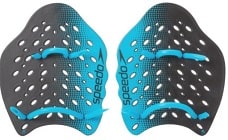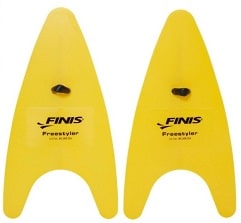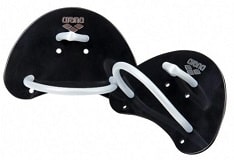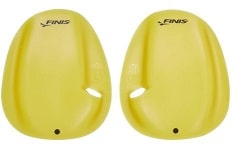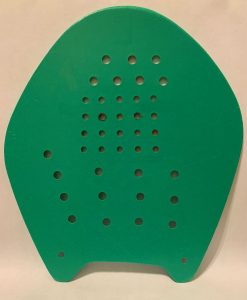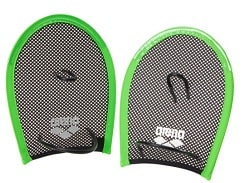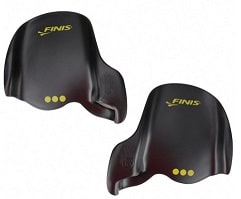Most swimmers have a love/hate relationship with swim paddles. On one hand, they can help you go faster in the water and develop upper body strength.
But they also make you focus on technique and correcting your stroke. Which can make some swimmers go slower as the paddles fix their stroke.
More Content for You: What Equipment Do You Need to Start Swimming?
Love them or hate them though, swim paddles (or hand paddles) are a great training tool to help during your swim.
However, not every paddle will work best for every swimmer. We’ve broken down 7 different paddles to help you find the best swim paddle for you!
Disclosure: This post may contain affiliate links, meaning we earn a small commission at no cost to you if you purchase something through one of our links. As an Amazon Associate, we earn from qualifying purchases. Please check out our disclosure page for more information.
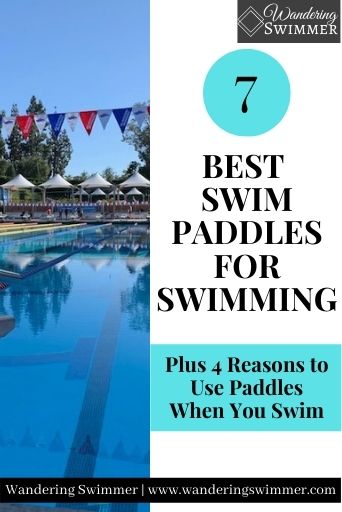
Best Swim Paddles for Swimming
- Speedo Power Paddle Plus: Best Overall
- FINIS Freestyler: Best for Freestyle
- Arena Elite Fingertip Paddles: Best for Stroke Work
- FINIS Agility Paddles: Best for Technique
- Strokemaker Paddles: Best Basic Paddle
- Arena Flex Paddles: Best for Elite/Competitive Swimmers
- FINIS Instinct Sculling Paddles: Best Paddle for Sculling
1. Speedo Power Paddle Plus
When it comes to a streamlined paddle that hits all the marks, Speedo’s Power Paddle Plus is the best option.
We like this paddle for a few reasons. In one way, it’s an upgrade from the classic Strokemaker Paddle design (reviewed later on this list). But Speedo added some flare to the sides of the paddles.
The wavy, scalloped edges help aid in pulling more water smoothly. While the curved edge near the top helps push through the water.
This design adds just a bit more surface area to the paddle. Enabling you to pull more while building strength and correcting your stroke.
More Content for You: How to Pick the Right Swim Goggles for You
The numerous holes throughout the paddle allow water to pass through the hard plastic. And also make it easier to place the straps so they best fit your hand.
The Power Paddle Plus can be used for all strokes and in any variation of training. From speed to drill work, it’s not limited to just one function. It’s a one-stop-shop for paddles 🙂
These paddles come in four sizes and colors are strictly based on size. Sizes range from small to extra large. We recommend getting paddles that are just a bit wider than your hand when it’s spread out.
2. FINIS Freestyle Paddles
As the name suggests, the FINIS Freestyler Paddles are best for, well, freestyle 🙂 From their tapered design to the rudder-like fin on the bottom. These fins provide instant (and sometimes harsh) feedback to your freestyle stroke.
Related article: A Swimmer’s Review of FINIS Freestyler Paddles
Specifically, the catch on your fingers through the pull of the stroke. Because if you enter the water wrong, the paddle will either fall off, twist to the side, or send your hand flailing around.
And if you don’t keep your hand steady as you pull through the water, you may struggle to keep the paddle on your hand.
Another thing these paddles help correct is ensuring correct entry. Some swimmers crossover too far in water, entering the water by their head instead of by the shoulder. These paddles will help guide those strokes into a more natural position, eliminating shoulder issues.
Some swimmers will complain about the lack of the wrist piece. But yes, this is intentional. And it’ll help you perfect your catch and pull without reverting to bad technique.
FINIS Freestyler paddles come in two sizes. Yellow for adults and white for junior/younger swimmers. Some older swimmers with existing shoulder issues may find that the junior size doesn’t agitate their shoulders as much.
3. Arena Elite Fingertip Paddles
At first glance, Arena’s Fingertip Paddles seem as though they’re missing the majority of their paddle. And in some ways, it is!
Arena’s Fingertip paddles are designed to fit only on the very tips of your fingers. So much so that they don’t go past your middle knuckles.
And while they’re not built so much for speed and shoulder strength, they are excellent paddles to work your stroke, catch, and reach. You’ll find that if you short your stroke and enter too soon, your hand will dive straight down.
More Content for You: The 7 Best Swim Caps for Long Hair
Yes, it can cause some frustration as you work to correct or build out your stroke. You’ll find yourself focusing on and correcting your hand entry and the way you pull the water. But that’s what these paddles do best!
We recommend using these paddles for drill or technique work. You can also use them for shorter sets or ones that are on rest instead of an interval.
You won’t go as fast with these compared to regular paddles, which gives you a chance to work your technique more.
Arena’s Elite Fingertip Paddles come in one size and are available in three different colors. The paddle is made from hard plastic and the straps are silicone.
4. FINIS Agility Paddles
Admittedly, we’re not the biggest fan of the FINIS Agility Paddles for main sets. Because they’re small and lightweight, it’s easier to use these in the water than other paddles on the list and does nothing for muscle/strength development.
Defeating part of the purpose of a swim paddle!
That said, we will admit that these paddles do have a place for correcting technique. We find that they’re best used for beginnings as they can help fix and guide your stroke.
Other swimmers can use these paddles during drill sets and take advantage of the self-correction/feedback that they provide.
At first glance, you’ll notice that these paddles have no straps to them. Instead, there’s a dipped spot to place your hand and a hole for your thumb. Aside from that, that’s all there is to the paddle!
More Content for You: 14 Gifts Swimmers Will Actually Use
But don’t let the simple design fool you. Much like the FINIS Freestyle Paddles, if you enter the water incorrectly, the paddle will fall off. Or it’ll catch the water wrong and send your arm flailing about.
Because of this, the FINIS Agility Paddles are great at correcting your technique. And figuring out where in your pull you’re not catching water.
It can lead to some frustration if the paddle keeps falling off. But stick with it and you’ll find yourself correcting your stroke.
These paddles only come in yellow and are available in three different sizes.
5. Strokemaker Paddles
Probably the most basic in design, Strokemaker Paddles have been around since before I started swimming.
My original pair lasted nearly ten years before cracking in half. They would’ve lasted longer but someone’s stroke reached over the lane line and hit my hand/paddle with their paddle. 🙁
These paddles don’t have special features or designs like other paddles on this list. But they’re good, sturdy paddles that will keep going.
Strokemaker Paddles will help you strengthen your stroke along with correcting any incorrect movements you might make. They can also increase the distance per stroke you take by working early recovery.
More Content for You: Basic Pool Etiquette: 15 Ways to Share the Pool
The company recommends keeping the wrist straps on but I always use mine without the wrist strap. As it encourages a clean stroke and keeps you from relying on the strap to guide your stroke.
If you’re new to paddles though, we recommend keeping the wrist strap on until you’re more comfortable with both the paddles and your stroke.
Like Speedo’s Power Paddles, these paddles have holes throughout the paddle for water to pass through. These also allow you to thread the straps through so they best fit your hand.
We like to place the finger strap so that it best fits around the middle finger.
Strokemaker Paddles come in six different sizes and have an incredibly handy chart to find your correct size.
6. Arena Flex Paddles
These paddles are…funky.
Whereas most of the paddles on this list are made from hard plastic, the Arena Flex Paddles are mainly made of mesh. They’re not best suited for any type of speed work. Rather, they’re better used for drill/technique work or during some easier swim sets.
The mesh portion of the paddle causes resistance, making it more difficult to pull the paddle through the water.
We’ll also note that the straps for both the finger and wrist can’t be adjusted. And because they’re set at a larger size, you constantly feel as though you’re going to lose the paddle.
More Content for You: Swimming Secrets: What Really Happens at Swim Practice
It takes some time and a steep learning curve to adjust to this paddle. However, the benefits that it adds through building up the strength of your stroke are worth the awkwardness of the paddle.
That said, we do recommend this paddle for older competitive swimmers. If you’re new to swimming, the paddle will only make you frustrated. And younger swimmers don’t need to worry about resistance like that just yet.
They come in black, green, and pink colors. And come in medium and large sizes.
7. FINIS Instinct Sculling Paddle
You can scull with almost any paddle. But FINIS Sculling Paddles will train and correct your sculling awareness.
This paddle can be tricky, as it has no straps to keep on your hand and only features an entry for your thumb. And it’ll fall away if you don’t maintain pressure against the water when you swim.
However, because the design keeps you focused on your stroke, it’s easier to find any issues and help correct them.
You can use these paddles for all four strokes, but we like using these specifically for sculling, as they allow you to feel/find the water. And if you’re sculling wrong, you get instant feedback.
More Content for You: End of the Swim Season Checklist
They’re not a 100% necessary training aid in your gear bag but they can be nice to have for drill/technique sets. If the place you train at happens to have them, we suggest trying them out though!
How Do You Choose the Right Swim Paddles?
With the wide variety of swim paddles available, how do you choose the best paddle for you? Consider some of these options when picking your next swim paddle.
Paddle size
Bigger isn’t always better with swim paddles. The larger the paddle, the more water you’ll have to pull and the more resistance you’ll have. Larger paddles are recommended for stronger and experienced swimmers who have developed the strength to pull the necessary water.
Generally, you’ll want to find a paddle that’s just a bit larger than your hand.
At this size, you can still develop your stroke with just the right balance of resistance, while building up your strength for a larger paddle. Once you feel that you can move up to a larger size, you can do so.
Ease of Use (Straps vs No Straps)
Not every paddle comes with straps. And some paddles that do have straps, only have straps for the finger(s) and not the wrist.
Straps help hold the paddle to your hand. And for some swimmers, the lack of straps may make it difficult to use the paddle while swimming.
We recommend looking at full-sized paddles with straps for both the finger(s) and wrist to start. As you become more comfortable with the paddle and the feel of it, you can start to remove the straps. Or look at paddles without straps.
Paddle Purpose
Not every paddle is made the same. Aside from the size and ease of use, some paddles are for one stroke specifically. Or should only be used during drill sets.
An example of this would be FINIS Freestyle paddles. As the name suggests, they’re used specifically for freestyle stroke.
Some paddles are also best suited for competitive swimmers. Such as paddles that add more resistance and build strength. Newer and lap swimmers may look for different paddles that focus more on technique than building muscle.
We recommend picking a paddle that best fits your goals and desired outcome in swimming.
Why Do You Need Paddles for Swimming?
In some ways, paddles are like fins in terms of training aids. People don’t think they need them since they already know how to swim.
Using paddles when you swim can add surface area around your hand. In turn, this helps swimmers move forward with ease and greater strength in the pull.
They can also help swimmers focus on their technique and improve any areas that need correction.
And yes, paddles can help you strengthen your upper body! This may not be a goal for everyone. But if it’s something you’re hoping to accomplish from swimming, using paddles will help you develop your shoulders and arms. More than you would by swimming without.
What are the Benefits of Using Paddles?
Paddles (and fins) have several benefits that you shouldn’t overlook when swimming. Such as:
- Correct stroke work and develop proper technique
- Help ease pressure and strain put on the shoulders while swimming
- Develop muscle strength in your arms and shoulders
- Pull more water and swim faster
That last one is a bit of a toss-up depending on who you talk to. Some swimmers believe that paddles make them slower because they have poor technique. Others, such as myself, love using paddles and find that they make me swim faster.
In Closing
Swimmers either love or hate swimming with paddles. But they’re an excellent training aid to work on correcting techniques. Just as they’re crucial to help strengthen the arms and shoulders while you swim.
We will note that every swimmer will have different paddles that work best for their own needs. Ask other swimmers what paddles they use and how they like them. And if you can, swim a few laps with them.
As always, happy swimming!
– Chevron
Bonus Content
8 Best Swim Bags for Swimmers and Water Enthusiasts: A swim bag is a swimmer’s best friend. They hold everything from towels and phones to goggles. We’ve broken down the 8 best swim bags for swimmers.
A Swimmer’s Review of Arena’s Team Line Parka: Parkas aren’t just for competitive swimmers. Anyone can use them as a means to stay warm in cold weather. One such parka is Arena’s Team Line Parka.
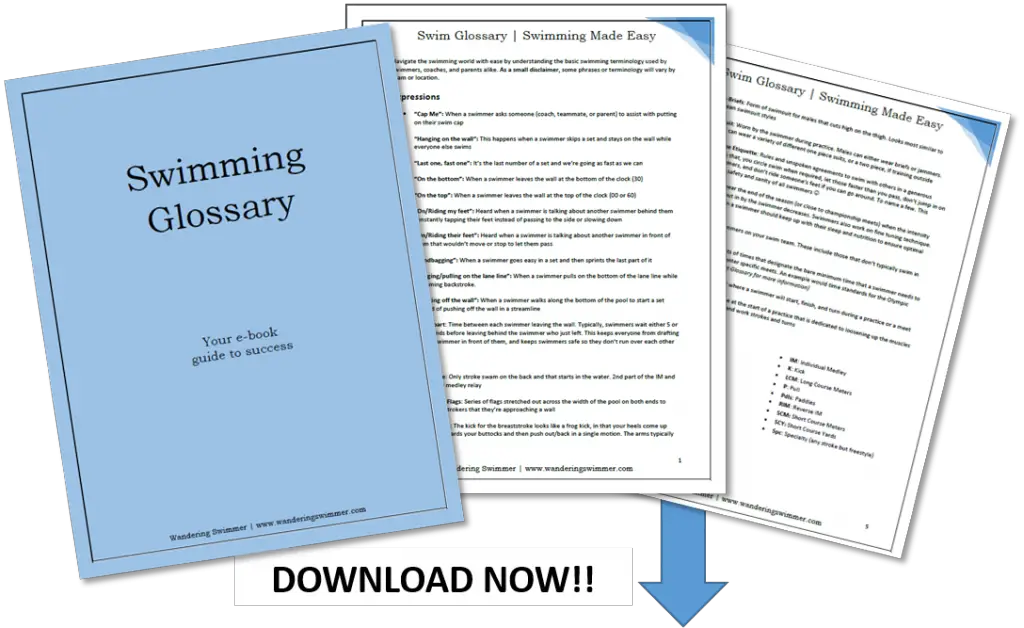
Want to Improve at the Pool?
Join swimmers and swim parents to receive my free newsletter and receive a free Swimming Glossary e-book as a thanks!
Every month you’ll receive tips and coaching to help you find success at the pool.
About
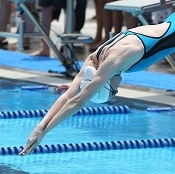
Chevron is a current competitive swimmer with almost 20 years of experience in the pool. And although she fell into the sport by accident in her high school years, she still trains daily and competes throughout the year. She’s committed to providing guidance to all levels of swimmers and believes that everyone should know how to swim.
